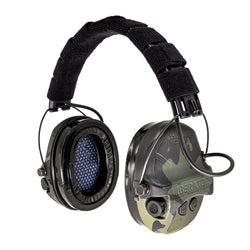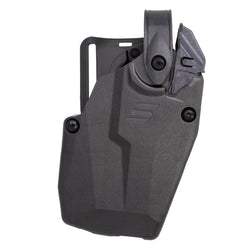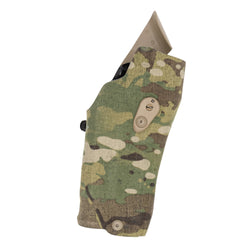In the age of the micro red dot, it is easy to overlook the iron sights that come stock in almost all handguns. Whether you own a handgun that is optics-ready or not, it is worthwhile knowing how to use the iron sights or, better yet, incorporating them into how you shoot.
But not all iron sights are created quickly. Some have blacked-out sights with no other characteristics, but many modern handguns come with either three-dot sights or tritium sights. Between the two, tritium night sights often make the difference between two models of identical handguns but at a higher price.
That begs the question: Are tritium night sights worth the hassle?

Tritium Sights: Weaponizing the Periodic Table
Iron, carbon, aluminum, copper, and lead. All are elements in the periodic table, and we make great use of them in guns and ammunition. Tritium is a relatively new material in the gun world, and unlike those others, it is not a solid but the exponent of a gas.
Tritium is a radioactive isotope of hydrogen. In fact, the name tritium literally translates from the Latin “third,” denoting it as the third isotope of hydrogen. The main properties to concern ourselves with are that tritium glows and has a half-life of just over 12 years—relatively short in the world of radioactive isotopes.
The glowing properties of tritium were first put to practical use in the 1950s for radioactive dating. In 1985, those properties were first incorporated on gun sights by the aeronautical engineer Glyn Bindon. Bindon introduced the proof of concept with the Spectrum Rifle scope, which was the first optic with an illuminated reticle. This scope debuted alongside the Bright & Tough Sight, the first tritium night sight.

The concept of night sights existed as far back as the Great War, with the use of radium-coated iron sights, but its high levels of radiation made it hazardous to use in any quantity. Tritium gave the desired glow and was safer to use.
In the new Bright & Tough Sight, the tritium was safely encapsulated in glass vials protected by the sights. These vials served as the sight picture and were hard to damage. In a nod to that early success, Bindon renamed his company Trijicon, which remains a forerunner in night sight technology.
Who Makes Tritum Sights?
Trijicon has expanded its lineup since its start in the 1980s to include a variety of rifle scopes, u-notch iron sights, and fiber optic sights. But their line of tritium night sights always takes front and center. The Bright & Tough Sight is still in production, as is the newer HD and DI Night Sights.
In addition to Trijicon, Meprolight has shot to the forefront of night sight tech, producing sights and tritium vials used in a number of stock pistols. TruGlo, XS, and Ameriglo round out the top five producers of night sights.
Tritium Night Sights: Pros and Cons
As with any gear decision, there are advantages and disadvantages to any setup. Whether you are looking to switch out your iron sights or eyeing a new pistol wearing night sights, it is worth asking if it is worth the hassle. The answer is going to depend on the pistol platform you choose and the expectations you have for that equipment.
Great for Little Guns
Tritium sights are becoming more popular on all handguns, but especially so on micro-compact and pocket-sized handguns. Traditionally, pistols like these would wear low-profile sights that are hard to acquire in a hurry. As it happens, these are the kinds of handguns that are hard to shoot well and could benefit from good sights.

Pocket pistols, in particular, benefit from night sights as they tend to neither be cut for, nor practical, with a red dot optic. Guns like the NAA Bugout and the Ruger LCP Max wear a non-adorned rear sight but feature an XS Big Dot tritium sight meant to pop out with a flash sight picture. A setup like this is not the best for target work, but it is unmatched in time to first hit, especially in lower light, where traditional sights would be useless.
Soft Pass for a Red Dot?
The ability to get a good working sight picture in low light in minimal time is the chief advantage of tritium night sights over conventional sights. That is especially useful in small guns, but can make or break a compact or full-sized handgun as well. But over the last several years, reflex optics, or RDOs, have gained in popularity.

This feature was once an ungainly bug of competition guns. Now it is quickly becoming standard equipment. RDOs have the benefits of low-light visibility with a reticle that is even more brilliant than the best night sights. It also eliminates the need to find the front sight and rear sight for traditional alignment, as all the shooter needs to do is find the dot in a point in space and fix it to the target before pressing the trigger.
There are quite a few handguns that come with tritium sights that also come from the factory optics-ready. In a worst-case scenario of an optics failure in low light, having tritium backup iron sights can still give you a sight picture. But under normal shooting conditions, the RDO does the job better, so much so that we might neglect our iron sight training and care.
Short Shelf Life
The case for tritium night sights on modern handguns gets murkier when it comes to the actual function of the sights themselves. Although we tend to call them tritium night sights, implying that they can be used at night, that doesn’t mean pitch-black darkness. The tritium gas does not glow well in the absence of light and shows up best when there is some residual light source.
Needless to say, tritium sights are not going to be the best for your night vision ops, but they show up brilliantly in the irregular light beams and black shadow of common nightlife.

Another factor to take into account is its limited shelf-life. A characteristic of tritium is a half-life of 12.3 years. In other words, an atom of tritium degrades by half in that span of time. It is a trade-off for safety. Toxic radium has a half-life of 1,600 years. Needless to say, radium will be there to stay, but if you keep a tritium sighted firearm for any length of time, you will notice that the vials lose their glow over time.
In my own experience, I have inspected Rhodesian FAL rifles with tritium front sights that predate the Trijicon era. These decades-old rifles had sights that still had the faintest glow, but I did not notice until it was pointed out to me. Needless to say, to keep your night sights in tip-top shape, new vials should be part of the occasional bit of maintenance.
Tritium Night Sights: No Harm, No Foul
Like red dots, tritium sights used to be something of a luxury item, but now they come stock on many different pistols. In fact, I own several handguns that have them, even though it was not advertised.
In spite of their shorter life and arguable redundancy in the age of the red dot, the advantages of having tritium sights are far more wide-reaching. They make small pistols and other non-RDO handguns easier to shoot in low-light conditions, where a majority of criminal encounters happen. Even with the latest handguns, they provide a resilient backup that can turn a dangerous encounter into a survivable one.









